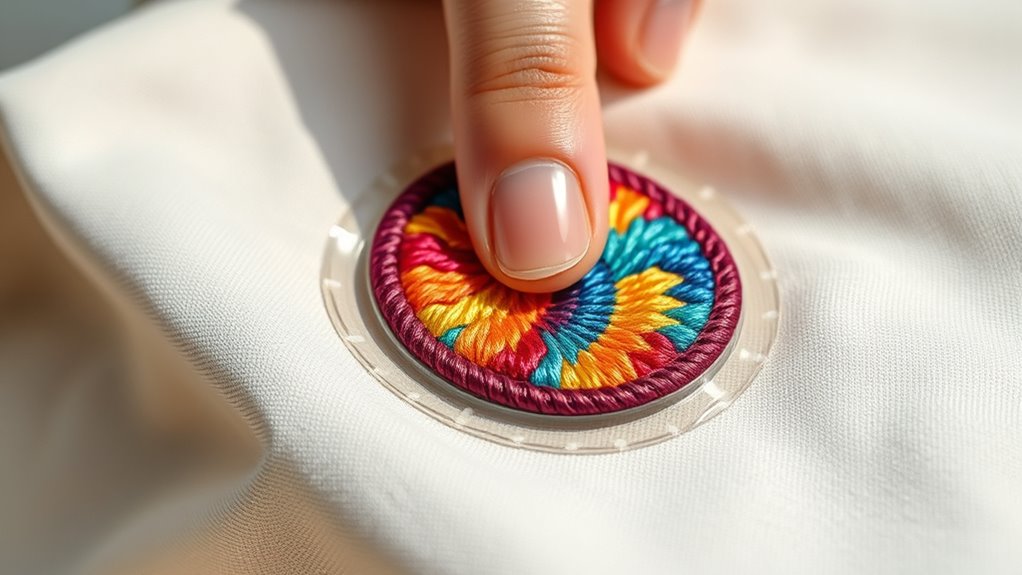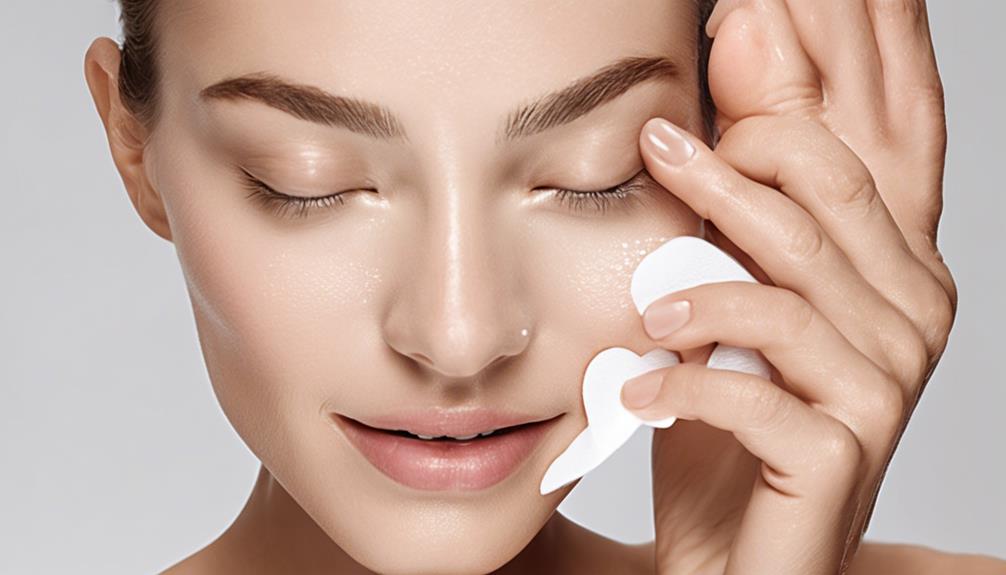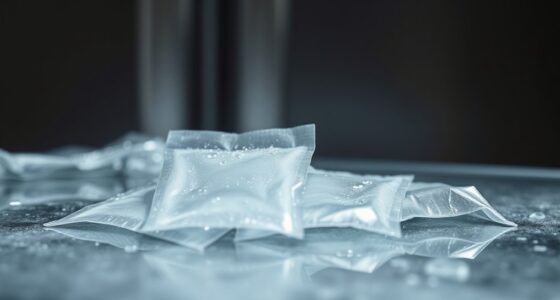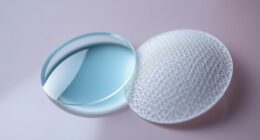To get patches to stay put, start with clean, dry skin, free of lotions or oils. Choose flat, less mobile areas and press firmly for at least 30 seconds after applying to activate the adhesive. Protect against moisture by using waterproof patches or coverings, especially during activities involving water or sweat. Handle the patch carefully, avoiding unnecessary repositioning. For longer wear and better adhesion, these tips can make a noticeable difference—if you want to learn more, keep exploring.
Key Takeaways
- Clean and dry the skin thoroughly before applying the patch to ensure optimal adhesion.
- Choose flat, less mobile areas to reduce lifting and improve sticking.
- Apply firm, consistent pressure for at least 30 seconds after placement to activate the adhesive.
- Avoid water, sweat, or humidity exposure; consider waterproof patches or protective covers in moist conditions.
- Handle the patch minimally after placement to prevent disrupting the adhesive bond and prolong wear.
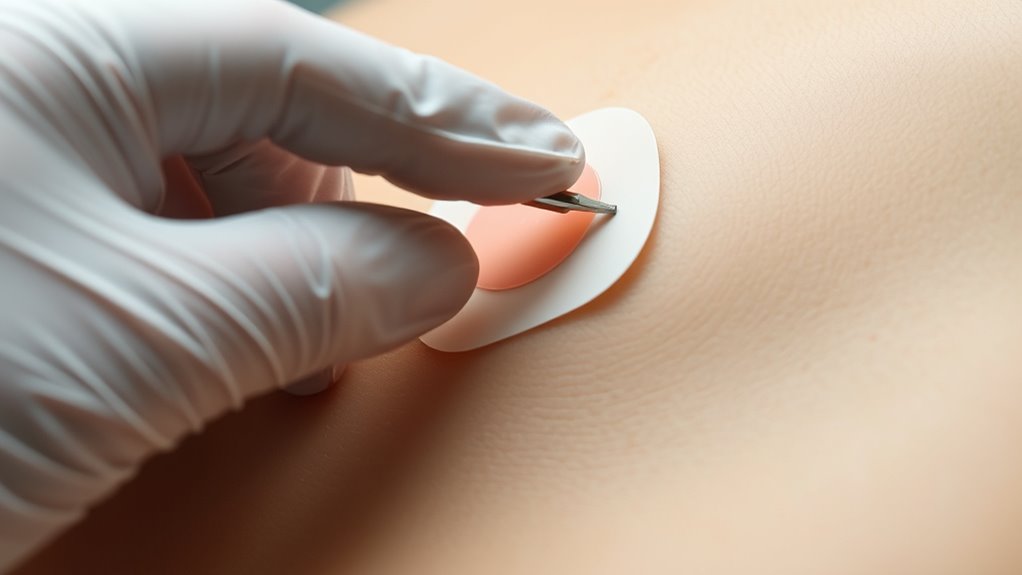
Are you struggling to guarantee your patches stay securely in place? If so, you’re not alone. Many people face issues with adhesion failure, which can compromise the effectiveness of the patch and reduce its longevity. The key to preventing this is understanding how to optimize your preparation and application techniques to ensure maximum adhesion. When a patch doesn’t stick properly, it’s often due to surface contaminants, skin oils, or moisture that interfere with the adhesive’s ability to bond. That’s why proper skin preparation is essential for improving patch longevity.
Start by cleaning the area thoroughly with soap and water, then dry it completely. Avoid using lotions, oils, or powders beforehand, as these can create a barrier that weakens the adhesive. If needed, you can gently wipe the area with an alcohol swab to remove residual oils or dirt. This ensures a clean, dry surface that allows the adhesive to form a strong bond with your skin. Proper preparation minimizes the risk of adhesion failure, extending the patch’s effective wear time.
Thoroughly clean and dry the area to ensure optimal patch adhesion and longevity.
Another tip involves choosing the right spot for application. Skin that moves a lot, like the joints or areas with a lot of friction, can lead to patch lifting or peeling prematurely. If possible, select a flat, less mobile area with minimal friction to improve adhesion and patch longevity. When applying the patch, press firmly and hold it in place for at least 30 seconds to activate the adhesive fully. This initial pressure helps the adhesive bond more securely, decreasing the likelihood of early detachment.
In addition, consider the environment in which you wear the patch. Excessive sweating, humidity, or water exposure can weaken the adhesive, causing adhesion failure. If you anticipate sweating or exposure to water, look for waterproof or water-resistant patches designed for those conditions. Wearing a protective cover or tape over the patch can also help reinforce sticking power, especially during activities that involve a lot of movement or moisture.
Lastly, once applied, avoid touching or repositioning the patch unnecessarily. Constant handling or adjustments can disrupt the adhesive bond, reducing both adhesion and patch longevity. If a patch begins to lift or peel, replace it promptly rather than trying to re-stick it, as reapplications often don’t hold as well. By following these tips—proper skin prep, strategic placement, environmental awareness, and careful handling—you greatly improve the chances of your patches staying in place, ensuring they work effectively for as long as they’re supposed to.
Frequently Asked Questions
How Long Can a Patch Typically Stay Attached Without Issues?
A patch can usually stay attached for about 24 to 48 hours without issues, but this depends on factors like skin type and activity level. Don’t fall for adhesion myths that suggest patches should stay on forever; proper application and skin prep extend patch longevity. To guarantee it stays put, keep the area clean and dry, and avoid excessive sweating or rubbing, which can compromise adhesion sooner.
Are There Specific Skin Types That Affect Patch Adhesion?
Certain skin types, like sensitive skin or overly moist skin, can affect patch adhesion. If your skin is sensitive, adhesives may not stick well or cause irritation. High moisture levels, from sweating or skincare products, can also loosen patches. To improve adhesion, clean and dry your skin thoroughly before applying, and choose patches designed for sensitive skin or with stronger adhesives. Adjusting these factors helps patches stay securely in place.
Can Using Lotion or Moisturizer Interfere With Patch Sticking?
Sure, slathering lotion or moisturizer before applying a patch is like trying to glue a sticker on a greasy pig—skin oils sabotage adhesion. These products create a slick barrier, making your patch slip and slide, and complicate patch removal with extra stubbornness. To keep things sticking, wash the area thoroughly and let it dry completely. Otherwise, you’ll spend more time removing patches than actually using them effectively.
What Are the Best Storage Conditions for Patches?
You should store patches in a cool, dry place away from direct sunlight to maintain their effectiveness. Keep them in their original packaging until use to preserve skin compatibility and prevent contamination. Avoid storing patches in humid areas like the bathroom. Proper patch storage guarantees they stay adhesive and safe for skin contact, which helps prevent irritation and ensures ideal performance when you need them.
How Often Should Patches Be Replaced for Optimal Effectiveness?
You should replace patches as recommended, usually every 24 hours or as directed by your healthcare provider. When removing patches, use gentle patch removal techniques to avoid skin irritation. If adhesive alternatives aren’t sticking well, consider switching to a different type of patch or applying a barrier film before placement. Regularly changing patches guarantees they stay effective and comfortable, preventing skin irritation and ensuring proper medication delivery.
Conclusion
Now that you know these patch adhesion tips, you’ll find it easier to keep your patches in place. Think of your skin like a smooth, sticky surface—like a freshly cleaned mirror ready to hold a sticker. By prepping your skin and choosing the right patch, you set yourself up for success. Stick with these simple tricks, and you’ll have patches that stay put just like a loyal friend, giving you confidence and comfort all day long.
